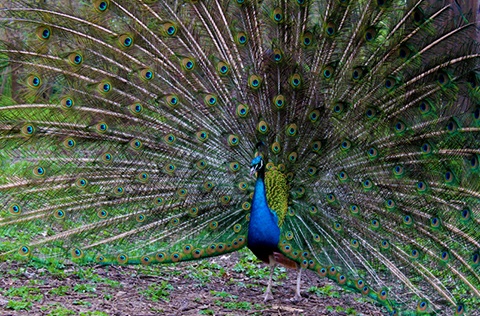Peafowl

Peafowl, which refers to male peacocks and female peahens, are not native to Texas. They were introduced to San Antonio several decades ago and have since become free-roaming wildlife in some residential areas.
Peafowl are omnivores and eat mostly plant parts, flower petals, seed heads, insects, reptiles, and amphibians. They typically forage for food during the early morning and in the evening. Peafowl are forest birds that nest on the ground, but roost in trees at night. As a non-native species, peafowl are considered “exotic fowl” by Texas Parks and Wildlife and are not protected by Federal laws. Peafowl are protected by cruelty laws.
For many residents, peafowl are a valued part of their neighborhood and serve as a beautiful attraction for the area. For others, peafowl are disruptive and destructive, as they can cause excessive noise, as well as damage to roofs, cars, and gardens. Many cities have enacted ordinances restricting or allowing peafowl management efforts (such as ordinances that prohibit feeding or enable trapping and relocating), but management of peafowl nuisance has been found to be best achieved through education on responsible behavior of neighborhood residents.
Mating Season
Peafowl mating season starts in early spring and lasts through early summer. You can tell mating season is approaching when male peacock train feathers begin to grow in. Peacocks fan their trains to attract the attention of female peahens, who will then build a nest by scraping a shallow hole in the ground, usually under a shrub or tall grass. Peahens lay anywhere from 3 to 12 eggs and will incubate them for 28-30 days before they hatch. During mating season, peafowl can make much more noise than usual, as the males will call out to attract females. Peafowl may also be more aggressive and territorial during this time. In mid to late summer, peacock train feathers begin to molt, indicating the end of mating season and a return to normal behavior.
Living with Peafowl
Proper Feeding & Population Control
Although legal, feeding wild peafowl is discouraged as they can thrive on plants, seeds, and insects they find on their own. Not only does foraging for food help build survival skills, but it also provides peafowl a more varied and nutritious diet than they would get from human-provided food. Additionally, because population is a direct representation of available resources, introducing an unnatural food supply could contribute to an increase in population and create a neighborhood nuisance.
If you do choose to feed peafowl on your property, provide only small amounts of food at a time, don’t feed by hand, and use a variety of food, such as seeds, plants, and insects. To prevent overfeeding, ensure that any leftover food that is provided is immediately removed and is not left unattended. Many believe “catch and kill” or “catch and relocate” is an effective population control method, these types of efforts are not effective over time and populations typically end up increasing back to their original size.
Not feeding wildlife is one of the most effective methods to control the population. Some cities have enacted ordinances that prohibit feeding wild peafowl or other wildlife as a means of managing wildlife population. These ordinances, however, are nearly impossible to enforce as there is typically no evidence to support an illegal feeding complaint. For example, one Texas city established an ordinance to prohibit residents from feeding deer. However, in 5 years, the City only issued 7 notices of violation and no citations. Therefore, the effectiveness of minimizing the impact of peafowl relies on responsible behavior and cooperation among neighbors.
How to Deter Peafowl from Your Property
- Use animal repellent, moth balls (naphtha flakes), or red pepper flakes
- Remove or cover food sources, such as pet food and compost bins
- Use water, such as motion-sensor sprinklers or a hose
- Trim or thin overhanging tree limbs
- Avoid outdoor decorative mirrors or reflective glass
- Cover or fence off young plants
- Cover gardens with gravel or rocks to prevent peafowl from using garden soil for bathing
- Landscape with plants peafowl dislike
Peafowl Regulation in San Antonio
It is unlawful to:
- Intentionally, knowingly, or recklessly beat, cruelly treat, or otherwise abuse wild peafowl
- Use inhuman traps, such as those with steel jaws, teeth, perforated edges, or snares
- Keep wild peafowl in a trap or cage without humane care
- Sell wild peafowl on any roadside, public right-ofway, commercial parking lot, garage sale, flea market, festival, park, community center or outdoor public place
- Hunt (capture, track, take, or kill) wild peafowl in a public road or right-of-way or on private property without the owner’s permission
It is lawful (but not encouraged) to:
- Feed wild peafowl
- Trap wild peafowl using a humane trap, which must be checked every 2 hours or every 8 hours if left overnight
- Humanely remove wild peafowl from one’s private property
- Hunt (capture, track, take, or kill) peafowl with a valid hunting license and the property owner’s permission (although it is illegal to discharge a firearm or use a bow and arrow within City limits)
- Humanely kill wild peafowl outside of the public’s view
- Sell wild peafowl from private property with a seller’s permit from the City